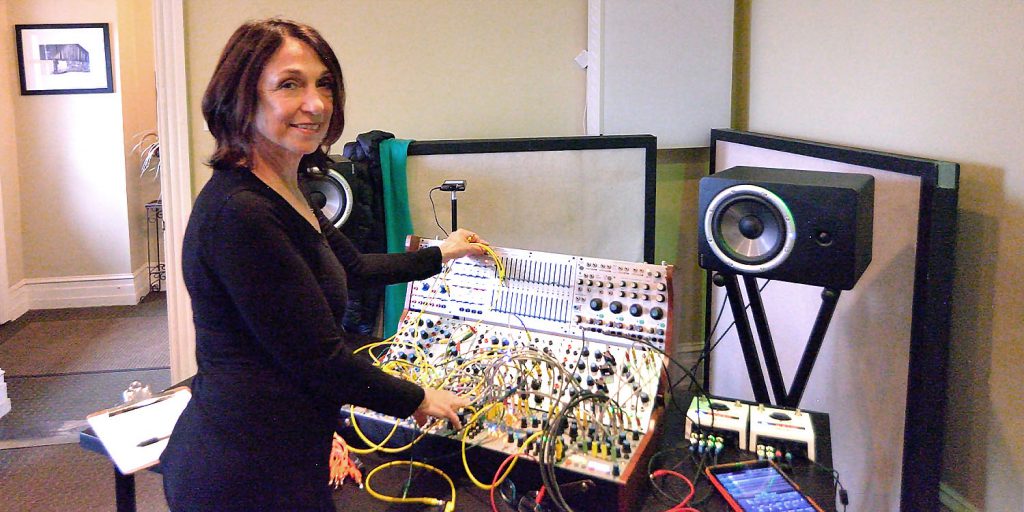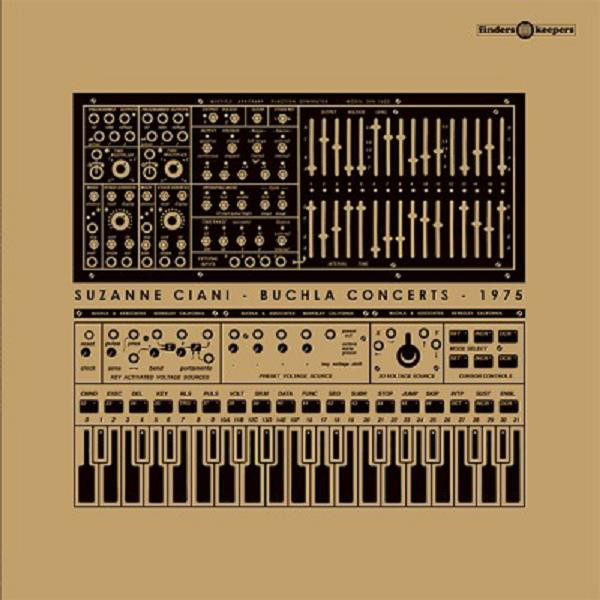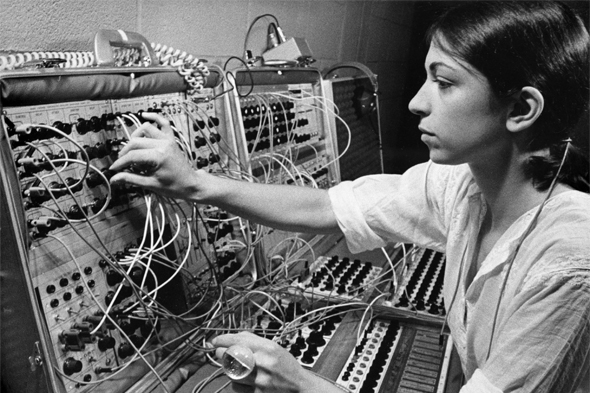Suzanne Ciani: An Electronic Pioneer Plugs Back In.
Podcast: Play in new window | Download
Subscribe: RSS
 Suzanne Ciani came to renown as a leading composer of jingles and sound effects for ads including a coke bottle popping and the talking GE dishwasher. Later on, she abandoned all that to pursue a career of romantic electronic and solo piano works releasing several albums on RCA and the Private Music label. Her career began in the pioneering days of electronic music and she has returned to that sound late in her life. We plug in, once again, with Suzanne Ciani.
Suzanne Ciani came to renown as a leading composer of jingles and sound effects for ads including a coke bottle popping and the talking GE dishwasher. Later on, she abandoned all that to pursue a career of romantic electronic and solo piano works releasing several albums on RCA and the Private Music label. Her career began in the pioneering days of electronic music and she has returned to that sound late in her life. We plug in, once again, with Suzanne Ciani.
Suzanne Ciani talks to synthesizers
“They do speak to me,” Ciani laughs. “Actually, they’re all, they’re all designed, this whole instrument is designed to give visual fee–feedback, so the cables are color coded. All the lights that you see blinking are indicators of what’s going on inside, so it’s a constant dialogue and conversation feedback with the instrument while I’m performing it.”
Suzanne Ciani is in the Echoes studio after finishing a live session on piano and Buchla synthesizer. With her long, brown bob, tight black dress and distinctly Italian features, she doesn’t look like your usual synthesizer nerd. The music Suzanne Ciani makes with the Buchla is a long way from the romantic keyboard compositions on which she built her reputation in the 1980s and 90s.
“By the time I started recording,” Ciani explains, “I decided to combine my classical roots with my electronic sensibilities. And the first album is all-electronic but it’s orchestrated. It was written out. It was played without a keyboard. It was very programmed because that’s what was available then. So that evolution of combining the electronic with the classical was my modus, you know, my form from then on.”
 That first album was called Seven Waves and it was released in 1982 on the avant-garde Finnadar label. Ciani refined that sound beginning with her second album, The Velocity Of Love. It established her reputation for romantic keyboard compositions. Now, just into her 70s and fifty years into her professional career, Ciani has returned to the sound and instrument she cut her teeth on, the Buchla modular synthesizer.
That first album was called Seven Waves and it was released in 1982 on the avant-garde Finnadar label. Ciani refined that sound beginning with her second album, The Velocity Of Love. It established her reputation for romantic keyboard compositions. Now, just into her 70s and fifty years into her professional career, Ciani has returned to the sound and instrument she cut her teeth on, the Buchla modular synthesizer.
The Buchla synthesizer was created about the same time as the Moog synthesizer and like that instrument, it took its name from its creator, Donald Buchla. Unlike the Moog, the Buchla did not have a keyboard.
“Yes, thank goodness,” Ciani declares, “because what happened, you know, when Moog put that black and white keyboard on the instrument, it kind of diverted the, the consciousness of what this new instrument could be.”
For a young woman composer in the 1970s, electronic music opened a door that had been nailed shut. “Part of the attraction, “explains Ciani, “was honestly that as a composer, the hurdles and the barriers to actually manifesting one’s composed music were just tremendous. They are for any composer, but for a female composer, it was particularly brutal. I can remember studying conducting at the University of California at Berkeley and being told that a woman had no place on the podium. There were just so many deeply confronting limitations that I think it was out of self preservation that I had this instinct that if I gave myself to this instrument, I’d have complete control over the sound.”
Once her career got underway, Ciani abandoned Buchla for many years. In fact, she pretty unplugged all her synthesizers in the first decade of this century. When we recorded her live for Echoes in 2002, it was strictly solo piano. But Don Buchla brought her back to electronic music again when they renewed their friendship a few years before his death in 2016. Then something funny happened, a record label in England, Finders Keepers, wanted to release some concert tapes of Ciani, all the way back from 1975.
“You know,it wasn’t until the album came out on Finders Keepers that I became aware that there was a renaissance now in electronic music,” Ciani claims, “and I got swept up in that.”
Ciani has found a late-in-life renaissance in her career, with a completely different audience and venues. She played Moogfest in 2016 and in 2017 she received the Moog Innovation Award. The shift didn’t come without conflict. After all, for some 30 odd years, Ciani was associated with a romantic, sometimes sentimental sound reflected on albums like Pianissimo, Hotel Luna and Dream Suite. But listen to her compositions and improvisations on the Buchla Modular Synthesizer and you would never know it was the same musician.
“Over these five years that I’ve been coming back to it, I’ve kind of admitted my dual identity,” she confesses. “I’m a double Gemini. Yeah, I know I have multiple identities.”
 In our studio, Ciani bends over her instrument, which unfolds from a suitcase. She explains how her music begins with a single sound. According to Ciani, “the sound originates in this oscillator and that oscillator has a wave shape. And…I can change the way it’s shaped. So that’s a square, all the way down to a sine wave. It’s going through this filter, so that’s gonna have some impact. So that’s where the wave starts, the sound starts here.” She could go on forever with variations and in fact in concert, that’s what she does, performing an hour long continuous set of themes and variation and explosions. In a live sold out performance at international house in Philadelphia, Ciani stopped twiddling part way through and started dancing, letting the synthesizer continue on its own.
In our studio, Ciani bends over her instrument, which unfolds from a suitcase. She explains how her music begins with a single sound. According to Ciani, “the sound originates in this oscillator and that oscillator has a wave shape. And…I can change the way it’s shaped. So that’s a square, all the way down to a sine wave. It’s going through this filter, so that’s gonna have some impact. So that’s where the wave starts, the sound starts here.” She could go on forever with variations and in fact in concert, that’s what she does, performing an hour long continuous set of themes and variation and explosions. In a live sold out performance at international house in Philadelphia, Ciani stopped twiddling part way through and started dancing, letting the synthesizer continue on its own.
“I listen to that patch when it settles in,” she enthuses. “There’s a, there’s a lot of randomness. Sometimes it really gels, and when it does, you can just step away and it’ll go on forever, and you don’t even need to be there. And I thought it got into a nice groove last night. And I thought ‘Okay, I’m taking some time off, I’m gonna dance. I don’t need to be twirling knobs right now, it’s under control in the machine'”
Suzanne Ciani has conducted a complete 180 degree turn in her career, so much so, that a piano performance is a rarity.
“Honestly, right now, the piano, because it is very physical, and I’m getting older…and really, and my hands are not as responsive as they were when I was younger,” she reveals. “And I think you know, the beauty of this, the instrument, is that it doesn’t, you know, it takes technique, but the technique is something that I can see being able to do when I’m 90.
But she adds, “What it takes is a brain though.”
Suzanne Ciani has the brain, and she can dance. She hasn’t released any new solo music, but you can hear her Buchla improvisations on the Buchla concerts 1975 recording from Finders Keepers records and an album of Buchla duets with Kaitlyn Aurelia Smith called Freakways 13: Sunergy on the RVNG Intl label.
